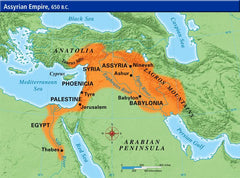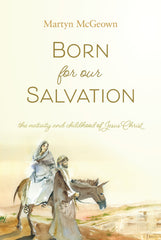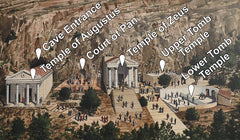Your cart is empty now.

"Heartily recommended to the reading public!"
Born For Our Salvation: The Nativity and Childhood of Jesus Christ, Martyn McGeown, Reformed Free Publishing Association, 2019. 288 pages, hardcover, $26.95. [Reviewed by Rev. Jonathan Langerak, pastor of Heritage Protestant Reformed Church in Sioux Falls, SD]
With delight this new book by author Martyn McGeown, missionary-pastor of the Limerick Reformed Fellowship, is heartily recommended to the reading public!
In this new publication the author addresses what by his own confession is “the greatest miracle in history”: the incarnation, birth, and childhood of our Lord and Savior Jesus Christ (1).
The format of the book’s twenty-one chapters clearly show they began life as sermons preached by the author to the saints of the Limerick Reformed Fellowship in Limerick, Republic of Ireland. Each chapter consists of three sections (one has two) that state, prove, explain, and apply the word of God in the gospel narratives in Matthew 1 and 2 and Luke 2, where the truth of the birth and childhood of Christ is revealed.
The book exhibits the exegetical excellence, clarity of expression, and beautiful simplicity that we have come to expect from this writer in his other volumes, also published by the RFPA. In this volume, he applies these gifts to the explanation of the truth we confess weekly in the Apostle’s Creed: “I believe in Jesus Christ...conceived of the Holy Ghost, born of the Virgin Mary.” Rev. McGeown’s book is no sappy, sentimental cooing over the birth of a baby in Bethlehem. Repeatedly he warns against such a view of Christ’s birth: “The nativity story must never be a sentimental story for us. The Son of God could easily have arranged better circumstances for himself.” Rather, Rev. McGeown explains the nativity and childhood of Christ as “the first step of Christ’s humiliation, which is his lowly birth. This is the first step that Jesus took in our salvation and the first step that would lead to his death on the cross (2).” The author draws our eyes of faith from the manger to the cross, whose shadow already fell over the stable of Bethlehem. The incarnation served the cross!
The book is based on exegesis expounding the meaning of the scriptures. We get wonderful exegesis, not only of the gospel narratives which reveal the incarnation and childhood of Christ, but also of the Old Testament prophecies which are fulfilled in the events of these chapters. For example, of Hosea 2 and 3 in chapter 17, “God’s Son Called Out of Egypt.”
On the basis of exegesis, the author also engages in polemics. Many of them are against the heresies of Rome, especially Rome’s exaltation of Mary: Rome’s corruption of the Creed of Chalcedon’s teaching that Mary is the “God-bearer, (25)” the immaculate conception of Mary, and Mary as co-redemptrix with Christ. Rev. McGeown opposes the popular notion of any kind of well-meant gospel offer in the song of the angels in Luke 2:12, but reminds us: “The song is God centered. The angels sing of God’s purpose...What a wonder of grace: the Savior is born, to the glory of God, according to God’s good pleasure, and as proof of God’s goodwill, to bring us peace (105, 107).”
Even the sanctified imagination which Rev. McGeown often expresses, in the opinion of this reviewer, delightfully, is governed by the word of God. A striking example is in chapter 1, “Gabriel’s Annunciation to Mary” (5–6):
Gabriel is therefore favored with making the most wonderful announcement the world has ever heard: the long-awaited Savior is to be born. We can well imagine Gabriel standing in the presence of God—in the presence of God whom he loved, adored, and worshiped. Long had Gabriel pondered the ways of God, for 1 Peter 1:12 reveals that the angels “desire to look into” the things of salvation. Suddenly, Gabriel receives a commission from the Almighty. First, Gabriel must make an announcement to Zacharias the priest and then, six months later, Gabriel must make an announcement to Mary.
Even though he engages in “sanctified imagination,” Rev. McGeown repeatedly reminds the reader that the purpose of God’s revelation in scripture, now, particularly, concerning the birth of his Son in our flesh, is not to satisfy our curiosity, but to lead us to magnify the incomprehensible works of God. Concerning Gabriel’s explanation in Luke 1:35 to Mary’s question as to how she would conceive “seeing I know not a man,” Rev. McGeown writes: “That is the only explanation that Gabriel gives. Beyond that we cannot go, for this is a wonder, a wonder of grace. God does not present it for our analysis, but for our adoration. Let us therefore worship the wonderworker of it, who is the Holy Spirit (22).”
At the same time, Rev. McGeown helps us to be conscious of the fact that the events of the birth of the Son of God in our flesh—which we often take for granted as we read them—caused chaos in the lives of those involved, and that this too was for us! In chapter 5, “An Angelic Dispelling of Joseph’s Fears” on Matthew 1:18–25, Rev. McGeown gently admonishes us: “We sometimes get quite sentimental about the nativity narratives. But we must remember that this is real human history, not a romantic fairy tale, and that the men and women involved in this history had their lives turned upside down (60).” Regarding the many angelic appearances—to Mary, the shepherds—that took place, the author says: “Sometimes, we are tempted to be envious of these men [the shepherds], but we should notice their reaction, and learn from it...If you want the living daylights scared out of you, by all means, desire an angelic visit. God will not grant your request, but you should at least understand what it would mean (91).” How many of us does this not convict?
In order to live up to its title “Born for our Salvation,” Rev. McGeown must bring out the gospel in all the events of Christ’s birth. This he does, repeatedly and beautifully. To mention a few: In his explanation of the name Jesus in chapter 5. In his reminder that “the baby Jesus cannot save us except by becoming the crucified and risen Jesus (84).” In reminding us in connection with God calling his Son out of Egypt that Jesus’ suffering in this flight was “because of our sins (219)” and that “through Jesus’ perfect obedience, his atoning sufferings and death, and his resurrection, God calls us out of Egypt also (224).” “Let us not dwell too long on the manger. Instead, let us lift our eyes to the cross, for it is not in the manger, but in the cross and in the empty tomb of the resurrected Lord, where our salvation is found (84).”
What is our reaction to the wonders of the nativity and childhood of Jesus Christ? Rev. McGeown calls us to wonder, adore, and magnify the name of God, the God of salvation, the God who is with us in Immanuel. “We must stand in awe of this word of God (20).” “Let us adore the mystery of the birth of the Son of God (84).” “We see from the angels’ song what is important to angels and should be important to us. Their first words are ‘Glory to God in the highest’ (Luke 2:14). Something, declare the angels in song, has happened in Bethlehem that reveals and displays the glory of God, and we have come to sing about it. And you should sing about it, too (100)!” The last note of the book is a doxology: “We praise him for the gift of his Son, God’s Son who was born to die for our salvation (278).” May all readers of this fine volume join Rev. McGeown in that praise!
The content of the article above is the sole responsibility of the article author. This article does not necessarily reflect the opinions and beliefs of the Reformed Free Publishing staff or Association, and the article author does not speak for the RFPA.

Donate
Your contributions make it possible for us to reach Christians in more markets and more lands around the world than ever before.
Select Frequency
Enter Amount












